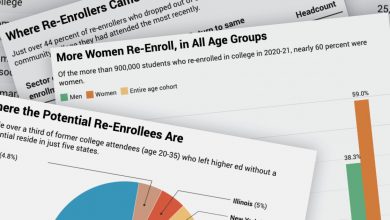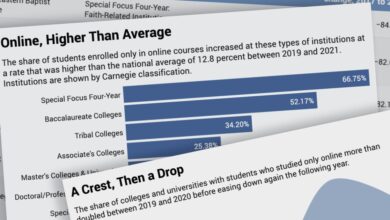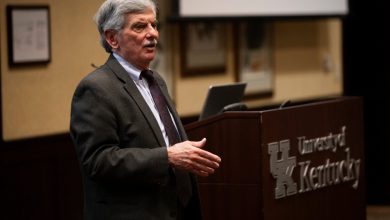Colleges Fear Cost of Doing Business Will Become Much Costlier

For many colleges, budgeting in 2023 is tougher than ever, according to experts. Tuition-dependent private institutions and increasingly tuition-dependent public colleges are facing lower revenues, thanks to enrollments depressed by the pandemic and ongoing demographic shifts. The nearly $80 billion in federal aid that buoyed institutions through the worst of Covid-19 is effectively gone. And the go-go economy that helped the country power through the worst of the past three years has cooled, sapping endowment performance and spiking inflation, which makes it more expensive to heat classrooms and feed students.
Enrollment represents the biggest stumbling block for many institutions. Undergraduate enrollment fell by about 4 percent nationwide between the fall of 2020 and the fall of 2022, according to data from the National Student Clearinghouse Research Center. Community colleges and their students were among those hardest hit by the pandemic; some two-year institutions lost as much as a quarter of their enrollments in the fall of 2020. Though community colleges have begun to recover, they lost nearly 7 percent of their enrollment between 2020 and 2022, according to National Student Clearinghouse data, compared to about 4 percent for public four-year colleges.
But traditional-age college students were becoming increasingly scarce before Covid-19 complicated matters. More than half of the states are projected to lose as many as 15 percent of their college-bound high-school graduates by 2029, according to Nathan D. Grawe, a professor of economics at Carleton College, creating even more intense competition among colleges for the dwindling number of first-time, first-year students available. And the recent national conversation over the price, and worth, of a degree has made college a tougher sell for some students and their families.
Many college chief financial officers are looking at tighter budgets for the next several years, primarily because of “pressure on enrollment due to decreasing number of high-school students and decreased interest in higher education,” says Paul N. Friga, a clinical associate professor of entrepreneurship and strategy at the University of North Carolina at Chapel Hill and a senior consultant for the Association of Governing Boards. The federal aid dollars that shielded colleges from the worst of Covid-related financial losses also helped shield them from budget deficits caused by insufficient net-tuition revenue.
In decades past, colleges might have mitigated precarious budgets by raising tuition, but that’s a hard row to hoe in 2023. The public narrative about student debt and the high price of college makes it difficult for any but the most in-demand institutions to increase tuition right now. The University of Illinois Board of Trustees last month approved 2 percent tuition increases for its Urbana-Champaign and Chicago campuses beginning in the fall of 2023, but many states and systems have kept tuition frozen for years.
The public colleges most feeling the financial squeeze from lowered enrollments are regional universities and community colleges, which typically receive less state support per student than public flagship universities. They are also charged with serving the most vulnerable populations, including first-generation and lower-income students, who are often more challenging to retain and need additional support, which sets up a catch-22 for public-college leaders when both state support and tuition revenue are tied to enrollment. If you’re keeping a public college on a lean diet of funding over many years, that damages its ability to adapt, says Felecia Commodore, an associate professor of educational foundations and leadership at Old Dominion University, “and now we’re demanding things of a lot of institutions that they need resources to execute.”
If you’re keeping a public college on a lean diet of funding over many years, that damages its ability to adapt.
Some private nonprofit colleges are in an even more precarious financial plight. The wealthiest and most selective institutions have enjoyed record numbers of applications in recent years, but many colleges that are heavily dependent on tuition revenue face possibly a decade or more of increasingly stiff competition for students. Private colleges raise tuition more readily than public colleges, says Rick Staisloff, founder of the higher-education consulting company rpk Group, but due to the current narrative about spiraling college prices, institutions can’t raise tuition much.
Raising tuition is a balancing act, says Christopher L. Gardner, chief financial officer at Wofford College, a small private institution in Spartanburg, S.C. Wofford’s applications are up, and its enrollment of about 1,800 students is stable. The college’s budget for fiscal year 2024 raises its sticker price of $51,530 in the 2022-23 academic year by about 4 percent, which is about average for annual increases in the recent past. But the net price that the institution actually charges its students, after aid is dispensed, will only increase about 2 percent, which is also about average for recent years.
Wofford is able to move forward with modest price increases because of its “steady market and solid demand,” Gardner says. “If we were trying to grow, we would struggle to eke out a price increase. If we had falling applications or falling levels of demand, we would struggle to eke out a price increase.”
Inflation remains high, at around 6 percent, and the biggest worry that it presents for college leaders comes from upward pressure on wages, says Staisloff. “If you have demand for higher wages, that’s going to be an extraordinarily difficult set of problems to solve for,” he says, “because you’ll be paying more, and you’re not getting any additional revenue to offset that.”
At Wofford, the last two years have seen the biggest increases in the overall dollar amount of employee salaries since the 2008-9 recession. “We’re making as much of an investment as we can,” says Gardner, “but I think we also have to be honest about the fact that we’re not quite keeping up with inflation for our folks.” While the college is raising its tuition price and net-tuition expectations this year, he adds, “we feel like there’s a disconnect between what kind of price increases our market can bear with our students and parents compared to the cost increases that our employees are experiencing.”
The California State University system is supposed to get an additional $227 million in new state support under a budget compact made in 2022 with Gavin Newsom, the state’s Democratic governor. But Deborah Wallace, vice president for administration and finance at Cal State-Dominguez Hills, knows that it may not amount to much for her institution, which would receive around 3 percent of the new funds. More than $90 million of the money has already been effectively set aside for possible increases in pay and benefits. All eight of the labor unions that represent workers in the system are set to reopen or renegotiate their contracts during the coming year.
Inflation can also affect larger financing, and over a longer term. In 2021, Dominguez Hills opened a new residence hall with 506 beds, planned and financed over several years, that cost about $60 million to build. The university is now in the planning stages for a new residence hall, the housing portion of which will contain only 365 beds in a similar footprint and will cost $75 million. “That’s a huge escalation in my mind,” Wallace says.
After nearly 15 years, it’s a truism to say that we’re closer to the next recession than we’re further away from the last one, in 2008-9. But there seems to be little clear sign whether the larger economy is headed up or down in the long term. S&P Global Ratings released a higher-education sector outlook in January that projected a brief and “shallow” recession for 2023 that would not affect colleges with strong finances.
Endowment performance had been one of the surprise silver linings of the pandemic as stronger-than-expected stock-market performance fueled a bonanza for colleges, and giving expanded. Donors gave $6.6 billion more to colleges nationwide in the fiscal year 2022 than the previous year, an increase of about 13 percent, according to the annual Insights on Voluntary Support of Education survey conducted by the Council for Advancement and Support of Education. But the bull market for endowment performance appears to be over. The annual average rate of return for U.S. college endowments leapt from less than 2 percent in the fiscal year 2020 to nearly 31 percent, according to data compiled for an annual survey by TIAA, a financial-services company, and the National Association of College and University Business Officers, known as Nacubo. In the fiscal year 2022, however, it fell by -8 percent.
As with so many other aspects of college finances, the benefits of endowment performance are not distributed evenly across higher education. The Nacubo-TIAA study found that the endowment values for a cohort of wealthiest colleges surveyed declined by an average of 3.8 percent, while the endowments of the remaining institutions declined by 9.6 percent. Universities with large, well-managed endowments were well-positioned to make the most of the Covid-era stock boom, and to benefit from the subsequent endowment windfalls, says Mark Krafft, a partner at Bain & Co., a consulting firm. Institutions with smaller endowments that are less well-managed “return less of the upside in market performance and more of the downside in any given year,” he adds. “So not only do they have smaller endowments, but they’re not as well protected against fluctuations,” such as those roiling markets now.
Each new budget offers a chance to restate, and redefine, what matters most to a college and its leaders.
A bad economy has not always been bad news for colleges. In 2010, community-college enrollment swelled to a historic peak of about 8 million credit-seeking students and 5 million non-credit students as workers displaced from the job market by the recession went back to school to improve their skills or switch careers. Two-year institutions have lost nearly 2 million credit-seeking students and 1 million non-credit students since then, in part because of a strong economy keeping people on the job. But the enrollment surge at two-year institutions that many expected could come from workers sidelined by Covid never arrived — many of the blue-collar adults they serve dropped out of both education and the work force for a time. The hundreds of free-college programs that have proliferated since the last recession could help encourage enrollment among displaced workers in the event of another economic downturn, but it remains to be seen what will happen.
In a word, budgets have to be strategic, even if money is tight — perhaps especially if money is tight.
Smart college leaders invested some of the money from the federal Higher Education Emergency Relief Fund into improving their institutions for a more sustainable future, says Friga, the professor at the University of North Carolina at Chapel Hill. But the federal dollars aren’t necessarily a permanent solution. At Cal State-Dominguez Hills, 67 percent of the student population is Latino/Latina, and 74 percent of the students are eligible for Pell Grants. The pandemic revealed a vast digital gap for students trying to continue their education, so administrators spent more than $16 million in federal aid on upgrading the institution’s internet and digital capabilities. Now all those upgrades have to be sustained and supported. “Any software or hardware that was purchased and implemented, at some point those contracts, again, will become due,” says Wallace, its vice president for administration and finance. Remote work during the pandemic expanded the use of a popular software suite and increased the size of Dominguez Hills’ contract with the company by “hundreds of thousands of dollars,” she adds. “The question is, how do we maintain that on an ongoing basis with the limited dollars that are coming down from the state.”
Friga says he is also concerned that many colleges are heading into another fiscal year overburdened by too much physical infrastructure for their current level of students, too many layers of administration, and too numerous “legacy” majors and academic programs with declining interest from students and potential employers. “I’m not saying make wholesale changes,” he says, “but at least have a continuous improvement where you’re evaluating.”
Many colleges still budget based on a practice informally known as “SALY” — “same as last year” — using past expenditures as a floor to plan from rather than re-examining all spending from zero on up. “What do we really have to spend?” Friga says. “What can we stop spending? And where do you need to invest for growth to take care of our people?
Growth is key. Simply cutting programs is no way to create a healthy, sustainable institution. Colleges may need to cut back on some programs, but then they “need to reallocate resources towards areas of growth,” says Staisloff. The challenge for many college leaders, he adds, lies in “not always understanding where those growth areas are.”
Decisions about cutting back and investing have to be based on data, and the answers may not always be intuitive. A program that brings in a lot of students for College A might not work at College B in the next town over that has a different market, a different price point, or a different reputation. While many institutions are pouring dollars into beefing up their admissions appeal, Friga says, that money might be better spent on improving retention through better mental-health and academic-support services: “That’s a better return on investment than marketing programs to get new students out of a diminishing pool.”
Colleges probably should consider more aggressive partnerships, whether consortia arrangements with other area institutions to share back-office functions and pool purchasing, or more ambitious arrangements such as merging with or acquiring other colleges, or sharing academic courses. Pooling academic resources across institutions represents one of the biggest cost savings available to colleges, but it remains a step few seem willing to take.
Despite periodic murmurings that maybe this will be the year that financial pressures lead to a wave of college closures, the chances are probably modest. About a dozen small private nonprofit colleges close every year, according to Robert Kelchen, a professor of educational leadership and policy studies at the University of Tennessee at Knoxville, and that number hasn’t varied over the last decade, no matter what the economy is doing.
While the sky may not be falling for higher education, Staisloff says “the cloud ceiling keeps dropping and dropping and dropping and dropping, and that’s getting harder to ignore.”
Source link






